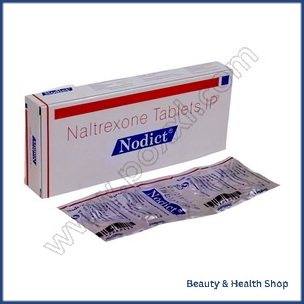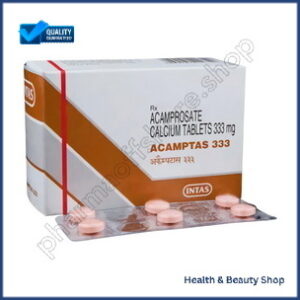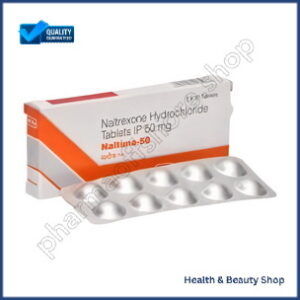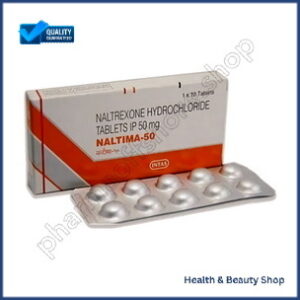ADDICTION
ALCOHOL DEPENDENCE
QUIT SMOKING
ALLERGY
ANTI FUNGAL
FUNGAL INFECTION
FUNGAL NAIL INFECTIONS
ANTI-REJECTION DRUGS
ANTI WORM
ANTIBIOTIC
BACTERIAL INFECTIONS
ARTHRITIS
GOUT
OSTEOARTHRITIS
RHEUMATOID ARTHRITIS
BLOOD
LOW PLATELET COUNT
THROMBOPHLEBITIS
VARICOSE VEINS
COLON
ANAL FISSURE
PILES
ULCERATIVE COLITIS
DIABETES CARE
DIABETES INSIPIDUS
DIABETES TYPE
DIABETIC FOOT ULCERS
GLUCOSE MONITOR
EYES/EAR CARE
DRY EYES
EYE CARE
EYE EXAMINATION
EYE INFECTION
EYE LASHES
EYE PAIN
GLAUCOMA
OCULAR HYPERTENSION
UVEITIS
FEVER CARE
MALARIA
RHEUMATIC FEVER
TYPHOID FEVER
GASTROINTESTINAL
ACIDITY
CONSTIPATION
CROHN'S DISEASE
DIARRHOEA
GALLBLADDER STONES
INTESTINAL ULCERS
IRRITABLE BOWEL SYNDROME
MOTION SICKNESS
NAUSEA
Nodict 50 mg (Naltrexone)
| Active Ingredient (Generic Name): | Naltrexone |
|---|---|
| Indication: | Opioid dependence, Alcohol dependence |
| Manufacturer: | 10 tablets in one strip |
| Packaging: | 10 tablets in one strip |
| Strength: | 50 mg |
From: $78.00
Nodict 50 mg, a medication containing Naltrexone, is used to treat opioid and alcohol addiction, as well as compulsive behaviors like pathological gambling and self-injurious behavior. As part of a comprehensive treatment plan, Naltrexone reduces cravings, prevents relapse, and modulates brain chemistry. Studies have shown that Naltrexone decreases relapse risk, improves treatment retention, and enhances quality of life. However, it can also cause side effects, interact with other medications, and has warnings. Understanding Nodict 50 mg‘s mechanism of action, benefits, and potential drawbacks is crucial for informed decision-making.
Main Points
? Nodict 50 mg (Naltrexone) is a medication used to treat opioid and alcohol addiction, as well as compulsive behaviors and self-injurious behavior, as part of a comprehensive treatment plan.
? It functions by binding to opioid receptors in the brain, thereby blocking the pleasurable effects of opioids and reducing the risk of relapse.
? Naltrexone treatment has been shown to decrease the risk of relapse, improve treatment retention, enhance quality of life, and reduce the risk of overdose.
? Common side effects of Naltrexone include nausea, headache, dizziness, fatigue, and insomnia. Rare but severe side effects can also occur.
? It is essential to inform your doctor about all medications and supplements, as Naltrexone may interact with opioids, antidepressants, and other medications.
What Is Naltrexone Used for
Naltrexone, the active ingredient in Nodict 50 mg, is primarily used to treat opioid and alcohol addiction, as well as manage certain compulsive behaviors.
Nodict 50 mg is prescribed to individuals struggling with opioid dependence or alcohol use disorder. Additionally, it is sometimes used to treat other conditions, such as pathological gambling or self-injurious behavior.
In the context of opioid addiction, Nodict 50 mg reduces cravings and prevents relapse. For those struggling with alcohol addiction, it decreases the desire to drink and reduces the risk of relapse. In cases of compulsive behaviors, Nodict 50 mg helps manage impulses and reduces the urge to engage in harmful activities.
Nodict 50 mg is typically used as part of a comprehensive treatment plan, which may include counseling, behavioral therapy, and support groups. Combining medication with these other approaches increases the chances of achieving long-term recovery and improving overall well-being.
How Nodict 50 mg Works
Nodict 50 mg operates by binding to opioid receptors in the brain, effectively blocking the pleasurable effects of opioids. This mechanism is crucial in understanding how Nodict 50 mg aids in overcoming addiction or maintaining sobriety.
Mechanism of Action
Nodict 50 mg’s mechanism of action involves the active ingredient naltrexone binding to opioid receptors in the brain, effectively blocking the pleasurable feelings associated with substance abuse.
Naltrexone works in the body through the following mechanisms:
- Opioid receptor antagonist: Naltrexone binds to opioid receptors, preventing other opioids from binding and activating the brain’s reward system.
- Blocking dopamine release: By blocking opioid receptors, naltrexone reduces the release of dopamine, a neurotransmitter associated with pleasure and motivation.
- Reducing cravings: By reducing the pleasurable effects of opioids, naltrexone decreases the motivation to use these substances, helping to reduce cravings and support recovery.
Opioid Blockade
Nodict 50 mg contains naltrexone, which binds to opioid receptors in the brain and spinal cord. These receptors transmit opioid-related signals, leading to feelings of euphoria and dependence. By occupying these receptors, naltrexone prevents opioids from binding and activating them, blocking their effects.
This blockade is specific to mu-opioid receptors, responsible for the rewarding and addictive properties of opioids. As a result, the typical high associated with opioid use is not experienced. Naltrexone’s strong binding affinity ensures opioids cannot displace it from the receptors. This potent blockade makes Nodict 50 mg an effective medication for managing opioid cravings and supporting addiction treatment.
Brain Chemistry
Nodict 50 mg’s mechanism of action involves modulating brain chemistry by targeting specific neurotransmitter systems, particularly the opioid and dopamine pathways.
When taken, naltrexone binds to opioid receptors in the brain, blocking the effects of opioids and reducing cravings. This is especially relevant for individuals struggling with opioid addiction.
In the brain, the following occurs:
- Opioid receptors are blocked, preventing opioids from attaching and producing feelings of euphoria.
- Naltrexone affects dopamine pathways, helping to normalize dopamine release and reducing cravings for opioids.
- By blocking opioid receptors and regulating dopamine levels, naltrexone helps reduce cravings and supports recovery from opioid addiction.
Mechanism of Action
Naltrexone, the active ingredient in Nodict 50 mg, binds to opioid receptors in the brain, blocking the effects of opioids and reducing cravings. This mechanism of action is essential in understanding how Nodict 50 mg helps overcome opioid addiction.
When taken, naltrexone is absorbed into the bloodstream, crosses the blood-brain barrier, and reaches the brain. It then binds to opioid receptors, occupying the sites where opioids would normally attach. This blocks the euphoric effects of opioids, making it less likely to experience a high. Consequently, brain chemistry is altered, and cravings for opioids decrease. This reduction in cravings is a significant step towards recovery, allowing focus on rehabilitation without the constant desire for opioids.
Understanding how Nodict 50 mg works at the molecular level highlights its role in supporting recovery from opioid addiction.
Benefits of Naltrexone Treatment
Research has consistently shown that naltrexone treatment reduces the risk of opioid relapse. By blocking opioid effects, naltrexone decreases cravings and overdose risk.
Naltrexone treatment benefits include:
- Decreased relapse risk: Naltrexone has been proven to lower the likelihood of opioid relapse.
- Improved treatment retention: Studies have found that naltrexone treatment increases treatment program completion and engagement.
- Improved quality of life: By reducing opioid cravings and use, naltrexone treatment improves overall quality of life, enabling individuals to focus on rebuilding relationships, finding employment, and achieving personal goals.
Opioid Dependence Treatment
Opioid dependence treatment often involves the use of Nodict 50 mg to reduce opioid cravings. When taken as part of a comprehensive treatment plan, Nodict 50 mg can decrease opioid cravings, making it easier to overcome addiction. This medication-assisted therapy approach combines Nodict 50 mg with counseling and behavioral therapies to provide a well-rounded treatment strategy.
Opioid Craving Reduction
Nodict 50 mg is a medication designed to manage opioid dependence by reducing opioid cravings.
Taking Nodict 50 mg leads to a decrease in the intense desire to use opioids, which is essential for overcoming opioid addiction.
Nodict 50 mg reduces opioid cravings in three ways:
- It binds to opioid receptors in the brain, preventing opioids from attaching and activating the reward system, which drives cravings.
- By blocking opioid receptors, Nodict 50 mg decreases the release of dopamine, a neurotransmitter associated with pleasure and reward, which contributes to opioid cravings.
- Nodict 50 mg helps regulate brain chemistry, reducing the emotional and physical distress that often leads to opioid cravings.
Medication-Assisted Therapy
Medication-assisted therapy combines Nodict 50 mg with counseling and behavioral therapies to treat opioid dependence. A healthcare provider will help create a personalized treatment plan addressing physical and emotional needs.
Nodict 50 mg is taken as prescribed to reduce opioid cravings. Concurrently, counseling sessions identify and change negative thought patterns and behaviors contributing to addiction. Behavioral therapies, such as cognitive-behavioral therapy (CBT), develop coping skills and strategies for maintaining sobriety.
Regular meetings with a healthcare provider monitor progress, adjust medication as needed, and address challenges. Combining medication with counseling and behavioral therapies helps overcome opioid dependence and achieve long-term recovery.
Managing Alcohol Addiction
Naltrexone, in the form of Nodict 50 mg, is a medication used to manage alcohol addiction. It reduces cravings and the pleasurable effects of alcohol consumption.
Nodict 50 mg works in three key ways to help manage alcohol addiction:
- Craving reduction: Naltrexone decreases the brain’s dopamine release, which is associated with the pleasurable effects of alcohol consumption. This reduction in dopamine release leads to reduced cravings.
- Alcohol consumption decrease: By blocking the pleasurable effects of alcohol, Nodict 50 mg makes drinking less enjoyable, resulting in decreased alcohol consumption.
- Recovery motivation: With reduced cravings and decreased alcohol consumption, individuals are more motivated to continue their recovery journey and maintain sobriety.
Compulsive Behavior Treatment
Treating compulsive behavior with Nodict 50 mg requires addressing underlying compulsive urges that drive behavior. Managing impulsive behavior is crucial, as it enables making informed choices. Breaking unhealthy habits allows regaining control over actions and developing healthier behavioral patterns.
Overcoming Compulsive Urges
Identifying and challenging distorted thoughts that contribute to compulsive urges is a crucial step in overcoming them. This involves recognizing patterns of negative self-talk and catastrophic thinking. Reframing these thoughts can lead to more balanced and realistic thinking patterns, reducing the urge to engage in compulsive behaviors.
To overcome compulsive urges, try the following strategies:
- Maintain a thought record to identify patterns and triggers of compulsive behavior.
- Practice self-compassion to reduce self-criticism and negative self-talk.
- Engage in regular relaxation techniques, such as deep breathing or progressive muscle relaxation, to reduce anxiety and stress that may contribute to compulsive urges.
Managing Impulsive Behavior
Managing impulsive behavior is crucial in treating compulsive behavior. Recognizing triggers that lead to impulsive decisions is essential. Developing coping mechanisms to overcome these triggers is vital.
Practicing mindfulness meditation can increase self-awareness and regulate emotions. Cognitive-behavioral therapy (CBT) can help identify and challenge negative thought patterns contributing to impulsive behavior.
Developing problem-solving skills enables critical thinking and informed decision-making. Setting clear goals and priorities helps maintain focus and avoid impulsive actions. Healthy coping mechanisms, such as exercise or creative pursuits, can manage stress and anxiety that may trigger impulsive behavior.
Implementing these strategies improves self-regulation skills and reduces impulsive behaviors. With time and practice, individuals can develop greater control over their actions and make intentional decisions.
Breaking Bad Habits
Breaking Bad Habits
Breaking bad habits requires identifying and addressing underlying motivations, patterns, and emotional triggers driving compulsive behavior. Compulsive behavior is often controlled by unconscious motivations rather than conscious intentions.
Taking Nodict 50 mg is a step towards recognizing and addressing compulsive behavior. However, personal effort is also necessary. To break bad habits, follow these essential steps:
- Identify triggers: Determine what situations, emotions, or people trigger compulsive behavior. This knowledge enables the development of strategies to avoid or cope with triggers.
- Replace old habits: Discontinue unwanted behavior by replacing it with a healthier alternative, such as a new hobby, exercise, or fulfilling activity.
- Create accountability: Share struggles with a trusted individual and request they hold you accountable, providing motivation to maintain new habits.
Impulse Control Disorder Treatment
Naltrexone, available as Nodict 50 mg, has been shown to reduce symptoms of impulse control disorders. It works by binding to opioid receptors in the brain, regulating the release of dopamine and other neurotransmitters associated with reward and pleasure. This reduces the reinforcing effects of impulsive behaviors, making it easier to manage impulses.
Research has demonstrated that Nodict 50 mg is an effective treatment for impulse control disorders, including kleptomania, pyromania, and intermittent explosive disorder. Studies have shown that naltrexone reduces the frequency and severity of impulsive behaviors, improving overall quality of life. Nodict 50 mg has been shown to be well-tolerated, with minimal side effects reported. If you’re experiencing impulsive behaviors, consult your doctor about Nodict 50 mg as a potential treatment option.
How to Take Nodict 50 mg
When taking Nodict 50 mg, follow the recommended dosage and administration instructions to ensure safe and effective treatment. Understand the precautions and warnings associated with Nodict 50 mg to minimize potential risks and interactions.
Dosage and Administration
Dosage and Administration
Take Nodict 50 mg orally, once daily, with or without food, as directed by your doctor. The dosage and administration of Nodict 50 mg are crucial for effective treatment. Follow your doctor’s instructions carefully to achieve the best results.
When taking Nodict 50 mg, remember:
- Take it at the same time daily to maintain a consistent level of the medication in your system.
- Swallow the tablet whole to avoid altering the release of the medication. Do not crush or chew the tablet.
- Do not stop taking Nodict 50 mg abruptly. If you need to stop, consult your doctor first to avoid withdrawal symptoms.
Precautions and Warnings
Before initiating treatment with Nodict 50 mg, disclose all medical conditions, medications, and supplements to your doctor to ensure safe and effective treatment. Naltrexone can interact with certain medications, such as opioids, and exacerbate specific medical conditions, including kidney or liver disease.
Inform your doctor if you have a history of drug or alcohol abuse, as Nodict 50 mg can trigger withdrawal symptoms in individuals physically dependent on opioids. If you are taking medications for diabetes, high blood pressure, or heart conditions, your doctor may need to adjust your dosage or monitor you closely while taking Nodict 50 mg.
Do not take Nodict 50 mg if you are experiencing opioid withdrawal symptoms or have taken opioids in the past 7-10 days. Avoid consuming alcohol while taking Nodict 50 mg, as it can increase the risk of liver damage.
Nodict 50 mg Dosage Information
Nodict 50 mg Dosage Information
The dosage of Nodict 50 mg and frequency of administration depend on the specific medical condition being treated and individual response to the medication. The doctor determines the appropriate dosage based on individual needs.
Dosage guidelines:
- Initial Dosage: Typically, treatment starts with a low dose of 25mg, which is gradually increased to 50 mg as needed and tolerated.
- Maintenance Dosage: Once the desired therapeutic effect is achieved, the dosage is adjusted to maintain that effect.
- Maximum Dosage: The maximum recommended daily dose of Nodict 50 mg is 100mg, but this should only be taken under close medical supervision.
Common Side Effects
Common side effects of Naltrexone include dizziness, nausea, headache, anxiety, insomnia, stomach pain, vivid dreams, and nightmares. These effects are typically mild and temporary, subsiding as the body adjusts to the medication.
Not everyone experiences side effects, and their severity varies from person to person. If you encounter any of these effects, consult your doctor to manage symptoms and adjust dosage if necessary. Your doctor may recommend over-the-counter medications to alleviate symptoms. It is essential to discuss any concerns with your healthcare provider.
Serious Side Effects
Naltrexone can cause serious side effects in rare cases. These reactions can be life-threatening and require immediate medical attention.
Some of the serious side effects to watch out for include:
- Hepatotoxicity: Naltrexone can cause liver damage, particularly with high doses or prolonged use. Regular liver enzyme monitoring is necessary.
- Allergic reactions: Severe allergic reactions can occur, manifesting as hives, swelling, or difficulty breathing. Seek immediate medical help if unusual symptoms appear.
- Suicidal thoughts: In rare cases, Naltrexone can increase suicidal thoughts or behaviors, particularly in individuals with a history of depression or substance abuse. Report any changes in mood or behavior to your doctor.
It is crucial to weigh the benefits of Naltrexone against the risk of these serious side effects. If concerned about your medication, consult your doctor or pharmacist for guidance.
Drug Interactions and Warnings
Naltrexone Interactions and Warnings
When considering Naltrexone, it’s essential to be aware of potential drug interactions and warnings. Naltrexone can interact with certain medications, including opioids, which may affect their efficacy or increase the risk of adverse reactions.
If you’re taking opioid medications, such as pain relievers or cough suppressants, your doctor may need to adjust your dosage or monitor you closely for signs of opioid withdrawal.
Inform your doctor about all medications you’re currently taking, including prescription and over-the-counter drugs, vitamins, and supplements. Naltrexone may interact with antidepressants, sedatives, and medications used to treat diabetes, high blood pressure, and seizures. Your doctor may need to monitor your liver enzymes and adjust your dosage accordingly.
Be aware of the following warnings associated with Naltrexone: risk of liver damage and allergic reactions. If you experience symptoms such as dark urine, yellowing of the skin or eyes, or severe abdominal pain, seek medical attention immediately.
Naltrexone Alternatives and Substitutes
If you’re unable to take Naltrexone or experience inadequate response, your doctor may consider prescribing alternative medications that target similar brain receptors or exhibit similar mechanisms of action. These alternatives can help manage opioid dependence, alcohol use disorder, or other conditions that Naltrexone is used to treat.
Alternative medications to Naltrexone include:
- Methadone, an opioid agonist that reduces withdrawal symptoms and cravings in opioid-dependent individuals.
- Buprenorphine, a partial opioid agonist that manages opioid dependence and withdrawal symptoms.
- Disulfiram, a medication used to treat chronic alcoholism by blocking the metabolism of alcohol and causing unpleasant symptoms when taken with alcohol.
Consult with your doctor to determine the best alternative medication for your specific condition and needs. They can help you weigh the risks and benefits of each option and find the most effective treatment plan for you.
Frequently Asked Questions
Can I Take Nodict 50 mg if I Have Kidney or Liver Disease?
If you have kidney or liver disease, exercise caution when taking medications. Your doctor will assess your condition and adjust the dosage or recommend alternative treatments to ensure safe and effective treatment.
Is Nodict 50 mg Safe to Use During Pregnancy or Breastfeeding?
Prior to taking Nodict 50 mg, pregnant or breastfeeding women should consult their doctor. The FDA categorizes medications for use during pregnancy and breastfeeding, but their safety is often unclear.
Can I Drink Alcohol While Taking Nodict 50 mg for Opioid Dependence?
When taking Nodict 50 mg for opioid dependence, it is recommended to avoid consuming alcohol. The combination can lead to adverse interactions, increased cravings, and hindered recovery progress, ultimately increasing the risk of relapse and related health complications.
How Long Does It Take to See the Effects of Nodict 50 mg Treatment?
Effects of Nodict 50 mg treatment typically become noticeable within 1-2 weeks, as brain chemistry adjusts and opioid cravings decrease. Full benefits may take 4-6 weeks, depending on individual response and dosage.
Can I Stop Taking Nodict 50 mg Abruptly Without Tapering the Dose?
Stopping Nodict 50 mg abruptly is not recommended. To minimize withdrawal symptoms and potential relapse, tapering the dose under a doctor’s guidance is advised.
Conclusion
Nodict 50 mg (naltrexone) is a medication used to manage opioid dependence. It works by blocking the effects of opioids on the brain. This medication is prescribed as part of a comprehensive treatment plan, which includes counseling and behavioral therapy. Naltrexone’s benefits include reducing opioid cravings and the risk of relapse. However, it may cause side effects such as nausea, headaches, and dizziness. Drug interactions and warnings should be discussed with a doctor.






